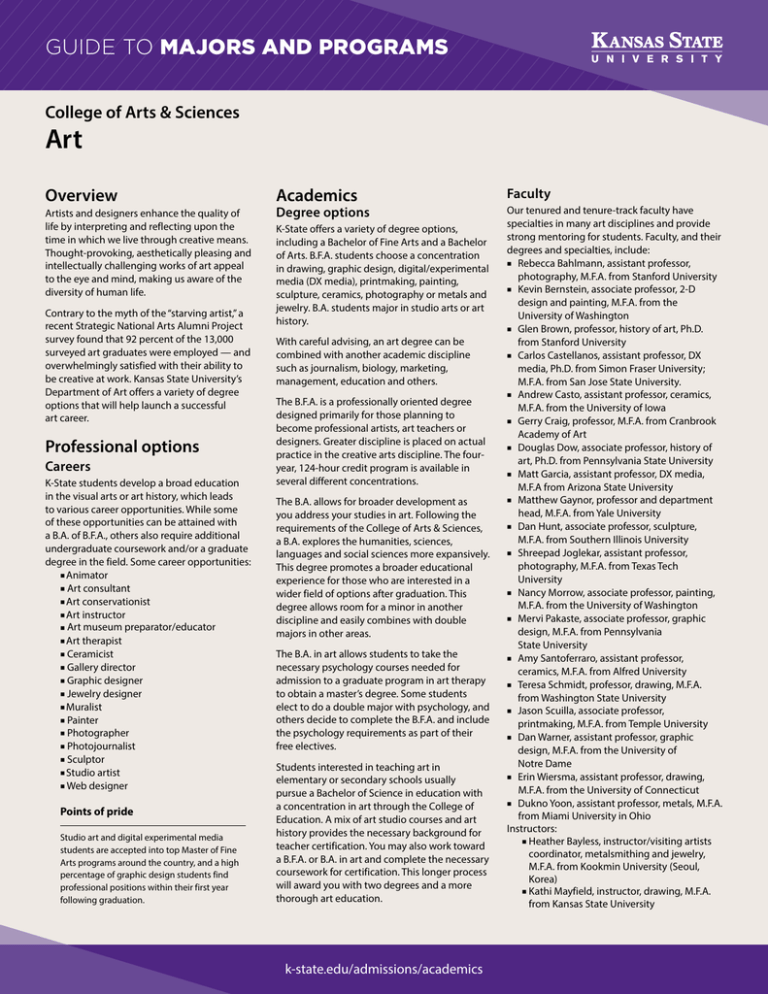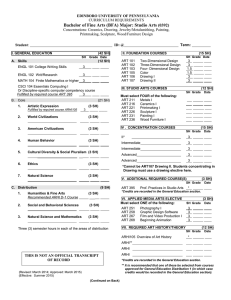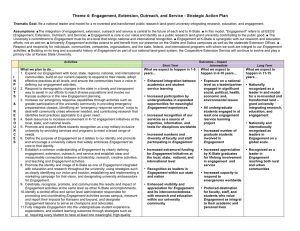Art MAJORS AND PROGRAMS GUIDE TO College of Arts & Sciences
advertisement

GUIDE TO MAJORS AND PROGRAMS College of Arts & Sciences Art Overview Artists and designers enhance the quality of life by interpreting and reflecting upon the time in which we live through creative means. Thought-provoking, aesthetically pleasing and intellectually challenging works of art appeal to the eye and mind, making us aware of the diversity of human life. Contrary to the myth of the “starving artist,” a recent Strategic National Arts Alumni Project survey found that 92 percent of the 13,000 surveyed art graduates were employed — and overwhelmingly satisfied with their ability to be creative at work. Kansas State University’s Department of Art offers a variety of degree options that will help launch a successful art career. Professional options Careers K-State students develop a broad education in the visual arts or art history, which leads to various career opportunities. While some of these opportunities can be attained with a B.A. of B.F.A., others also require additional undergraduate coursework and/or a graduate degree in the field. Some career opportunities: n Animator n Art consultant n Art conservationist n Art instructor n Art museum preparator/educator n Art therapist n Ceramicist n Gallery director n Graphic designer n Jewelry designer n Muralist n Painter n Photographer n Photojournalist n Sculptor n Studio artist n Web designer Points of pride Studio art and digital experimental media students are accepted into top Master of Fine Arts programs around the country, and a high percentage of graphic design students find professional positions within their first year following graduation. Academics Degree options K-State offers a variety of degree options, including a Bachelor of Fine Arts and a Bachelor of Arts. B.F.A. students choose a concentration in drawing, graphic design, digital/experimental media (DX media), printmaking, painting, sculpture, ceramics, photography or metals and jewelry. B.A. students major in studio arts or art history. With careful advising, an art degree can be combined with another academic discipline such as journalism, biology, marketing, management, education and others. The B.F.A. is a professionally oriented degree designed primarily for those planning to become professional artists, art teachers or designers. Greater discipline is placed on actual practice in the creative arts discipline. The fouryear, 124-hour credit program is available in several different concentrations. The B.A. allows for broader development as you address your studies in art. Following the requirements of the College of Arts & Sciences, a B.A. explores the humanities, sciences, languages and social sciences more expansively. This degree promotes a broader educational experience for those who are interested in a wider field of options after graduation. This degree allows room for a minor in another discipline and easily combines with double majors in other areas. The B.A. in art allows students to take the necessary psychology courses needed for admission to a graduate program in art therapy to obtain a master’s degree. Some students elect to do a double major with psychology, and others decide to complete the B.F.A. and include the psychology requirements as part of their free electives. Students interested in teaching art in elementary or secondary schools usually pursue a Bachelor of Science in education with a concentration in art through the College of Education. A mix of art studio courses and art history provides the necessary background for teacher certification. You may also work toward a B.F.A. or B.A. in art and complete the necessary coursework for certification. This longer process will award you with two degrees and a more thorough art education. k-state.edu/admissions/academics Faculty Our tenured and tenure-track faculty have specialties in many art disciplines and provide strong mentoring for students. Faculty, and their degrees and specialties, include: n R ebecca Bahlmann, assistant professor, photography, M.F.A. from Stanford University n Kevin Bernstein, associate professor, 2-D design and painting, M.F.A. from the University of Washington n Glen Brown, professor, history of art, Ph.D. from Stanford University n C arlos Castellanos, assistant professor, DX media, Ph.D. from Simon Fraser University; M.F.A. from San Jose State University. n A ndrew Casto, assistant professor, ceramics, M.F.A. from the University of Iowa n G erry Craig, professor, M.F.A. from Cranbrook Academy of Art n D ouglas Dow, associate professor, history of art, Ph.D. from Pennsylvania State University n M att Garcia, assistant professor, DX media, M.F.A from Arizona State University n Matthew Gaynor, professor and department head, M.F.A. from Yale University n D an Hunt, associate professor, sculpture, M.F.A. from Southern Illinois University n S hreepad Joglekar, assistant professor, photography, M.F.A. from Texas Tech University n N ancy Morrow, associate professor, painting, M.F.A. from the University of Washington n M ervi Pakaste, associate professor, graphic design, M.F.A. from Pennsylvania State University n A my Santoferraro, assistant professor, ceramics, M.F.A. from Alfred University n T eresa Schmidt, professor, drawing, M.F.A. from Washington State University n J ason Scuilla, associate professor, printmaking, M.F.A. from Temple University n D an Warner, assistant professor, graphic design, M.F.A. from the University of Notre Dame n Erin Wiersma, assistant professor, drawing, M.F.A. from the University of Connecticut n Dukno Yoon, assistant professor, metals, M.F.A. from Miami University in Ohio Instructors: nH eather Bayless, instructor/visiting artists coordinator, metalsmithing and jewelry, M.F.A. from Kookmin University (Seoul, Korea) nK athi Mayfield, instructor, drawing, M.F.A. from Kansas State University J ay Risner, instructor, digital arts, B.F.A. Kansas State University nN elson Smith, instructor, drawing, painting and sound art, M.F.A. from Cranbrook Academy of Art n Facilities The Mark A. Chapman Gallery on the first floor of Willard Hall opened in 2005. A complete renovation of the former Willard Hall Gallery increased the exhibition space to more than 1,400 square feet, along with 400 square feet dedicated to exhibition preparation and kitchen facilities. The Department of Art hosts B.F.A. and M.F.A. student exhibitions in the gallery as part of graduation requirements each semester. The technology-friendly gallery serves not only student exhibition purposes, but also provides a location for an active visiting artist lecture and exhibition program. Activities Clubs Art students have the option to join many student clubs and organizations: n AIGA n Digital/New Media Club n K-State Metals Club n Potters Guild n Pussycat Press n Drawing/Painting Collaborative n Sculptural Alliance Study abroad Art students are highly encouraged to study abroad. The experience makes students’ education more exciting and helps them become more creative artists by seeing how other parts of the world do things differently. The university offers dozens of exchange agreements where students can study for a semester or a year and pay the same K-State tuition. Occasionally, the university also offers art faculty-led programs. Admissions No portfolio review is required to declare art as a major. Students begin taking foundation classes immediately in preparation for the concentration admission review for the B.F.A. program. B.F.A. requirements The concentration admission review is required before admission to your chosen area of concentration. A display of selected work from your completed art foundation core courses occurs during the semester when you finish the last of the eight core classes, usually the fourth semester. Visual coursework must meet faculty approval. Upon passing the concentration admission review, you may begin B.F.A. study in your area of concentration. An additional review opportunity is allowed after an unsuccessful attempt to pass the concentration admission review. It may, if requested, occur in an area different from the first attempt. You may apply twice to each concentration. Bachelor of Arts in art history course requirements Financial assistance Hrs.Courses 3 Survey Art History I 3 Survey Art History II 6 Two 20th Century Art History courses 1 ART 105 Careers in Art Seminar 3 ART 180 2-D Design 3 ART 190 Drawing I 3 ART 200 3-D Design 3 ART 210 Drawing II 3 ART 325 Figure Drawing I 3 2-D elective* 3 3-D elective** 15 Credits of art history 49 Scholarships Students will have several opportunities to apply for portfolio scholarships through the department. New incoming freshmen and transfer students are invited to submit a portfolio to the department for our annual incoming student portfolio scholarship review that takes place each spring during K-State’s Open House. Visit art.k-state.edu/undergrad for more information. Suggested coursework 75 Basic college requirements and electives 124 total Bachelor of Fine Arts course requirements Hrs.Courses 3 Survey Art History I 3 Survey Art History II 6 Two 20th Century Art History courses 3 Art history elective 1 ART 105 Careers in Art Seminar 3 ART 180 2-D Design 3 ART 190 Drawing I 3 ART 200 3-D Design 3 ART 210 Drawing II 3 ART 325 Figure Drawing I 3 2-D elective* 3 3-D elective** 3 2- or 3-dimensional course choice *** 21 Major concentration 15 Art electives 2 B.F.A. Exhibition 78 Art and Art History classes *2-D electives include Type and Design, Oil Painting I, Photography in Art, Printmaking I and Watermedia I. **3-D electives include Ceramics I, Metalsmithing and Jewelry, and Sculpture I. *** ART 330 Digital Techniques in Visual Art can be this 2-D or 3-D course choice. 46 Basic college requirements 124total Bachelor of Arts in studio art course requirements Hrs.Courses 3 Survey Art History I 3 Survey Art History II 6 Two 20th Century Art History courses 1 ART 105 Careers in Art Seminar 3 ART 180 2-D Design 3 ART 190 Drawing I 3 ART 200 3-D Design 3 ART 210 Drawing II 3 ART 325 Figure Drawing I 3 2-D elective* 3 3-D elective** 9 Upper level studio classes in one area 6 Upper level studio classes in a second area (At least two of the 15 credits of upper level studio classes must be 300 level or above.) 49 Art and Art History classes *2-D electives include Type and Design, Oil Painting I, Photography in Art, Printmaking I and Watermedia I. **3-D electives include Ceramics I, Metalsmithing and Jewelry, and Sculpture I. 75 Basic college requirements and electives 124 total For more information about art, contact: Department of Art Kansas State University 111 Willard Hall 1211 Mid-Campus Drive North Manhattan, KS 66506-3705 785-532-6605 Fax: 785-532-0334 art@k-state.edu art.k-state.edu For more information about Kansas State University, contact: Office of Admissions Kansas State University 119 Anderson Hall 919 Mid-Campus Drive North Manhattan, KS 66506-0102 1-800-432-8270 (toll free) or 785-532-6250 k-state@k-state.edu k-state.edu/admissions Notice of nondiscrimination Kansas State University prohibits discrimination on the basis of race, color, ethnicity, national origin, sex (including sexual harassment and sexual violence), sexual orientation, gender identity, religion, age, ancestry, disability, genetic information, military status, or veteran status, in the University’s programs and activities as required by applicable laws and regulations. The person designated with responsibility for coordination of compliance efforts and receipt of inquiries concerning nondiscrimination policies is the University’s Title IX Coordinator: the Director of the Office of Institutional Equity, equity@k-state.edu, 103 Edwards Hall, Kansas State University, Manhattan, Kansas 66506, (785) 532-6220. The campus ADA Coordinator is the Director of Employee Relations, charlott@k-state.edu, who may be reached at 103 Edwards Hall, Kansas State University, Manhattan, Kansas 66506, (785) 532-6277. 2016


